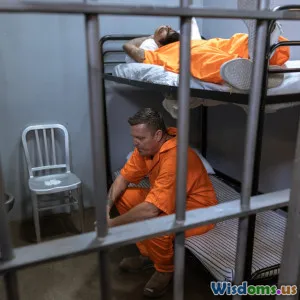
A Former Wardens Lessons for Managing HighSecurity Correctional Facilities
8 min read Insightful lessons from a former warden on effectively managing high-security prisons safely and humanely. (0 Reviews)
A Former Warden's Lessons for Managing High-Security Correctional Facilities
Introduction
Did you ever wonder what it truly takes to manage one of the most difficult environments in our justice system — a high-security correctional facility? The stakes are incredibly high, with risks ranging from inmate violence to staff burnout and the complex challenge of rehabilitation behind razor wire. Drawing on decades of experience, former wardens offer invaluable lessons that combine operational rigor, empathetic leadership, and innovation. This article delves deep into these lessons, revealing insights critical not only for prison officials but also for policymakers, criminal justice reform advocates, and anyone interested in how order is maintained where chaos easily looms.
Understanding the High-Security Environment
High-security prisons house the most dangerous offenders — those who pose serious risks to society and prison staff if not managed with strict precision. The environments are designed to minimize escapes, violence, and disruptions, often featuring enhanced surveillance, controlled movement, and limited privileges.
However, the serious security measures can create an atmosphere ripe for tension. Former Warden Angela Morris, who led a notable high-security prison for over a decade, recalls, “Every day felt like a balancing act between control and humanity. Too much control breeds anger, too little threatens safety.” This delicate balance necessitates a comprehensive understanding not only of security protocols but also of prison culture and psychological dynamics.
Lesson 1: Leadership is the Keystone of Security and Morale
Many challenges within high-security facilities stem from leadership failures rather than inmate behavior alone. Effective wardens know that the line between order and chaos depends on strong, ethical, and transparent leadership.
Lead by Example
Angela Morris credits her success to visibility and consistency. She regularly toured cell blocks, engaging with staff and inmates alike, demonstrating that she was neither distant nor authoritarian. This approachable stance built trust within the entire institution — a vital element often underestimated.
Empower Your Team
Frontline correctional officers are the first and most frequent point of contact with inmates. Empowering them with clear expectations, ongoing training, and opportunities for input has a domino effect on the entire facility's atmosphere. Data from the National Institute of Corrections indicates that prisons with engaged leadership experience 30% fewer violent incidents.
Lesson 2: Balance Hard Security with Rehabilitation Efforts
One common misconception is that prisons should focus solely on punishment and security. Former wardens emphasize the necessity of incorporating rehabilitation programs even in maximum-security settings. Morris explains, “Ignoring rehabilitation is a missed opportunity that fuels recidivism. Even the highest-risk inmates benefit from education, mental health care, and vocational training.”
Implementing Effective Programs
Programs must be tailored to meet the unique needs of the inmate population. For example, a high-security facility might emphasize anger management and cognitive behavioral therapy, while also providing educational courses that develop job skills in controlled environments.
Real-World Impact
A 2019 Department of Justice report demonstrated that maximum-security prisons incorporating structured behavioral programs and educational opportunities saw significant reductions in inmate misconduct and a notable impact on post-release success rates.
Lesson 3: Use Technology to Enhance, Not Replace, Human Judgment
Modern advancements have dramatically shifted security capabilities — from biometric identification to AI-driven surveillance. While technology can provide powerful tools, former wardens caution against over-reliance.
The Role of Technology
Technology assists in monitoring, communicating, and incident response. For instance, closed-circuit television helps monitor blind spots, and electronic door controls streamline movements. Yet, the judgment required in nuanced situations cannot be fully replaced by machines. Morris notes, “Technology is an aid; effective security relies on trained staff who know how to interpret and act on what technology reveals.”
Lesson 4: Foster a Culture of Safety for Staff and Inmates Alike
A safe facility is one where both inmates and staff feel secure. Achieving this involves cultivating mutual respect and clear communication channels.
Addressing Staff Stress
Correctional officers face high stress levels, with risks of burnout and PTSD. Former wardens advocate for comprehensive support programs including counseling, peer support groups, and resilience training.
Promoting Respectful Inmate Interaction
Policies encouraging respectful communication mitigate conflict. Morris shares, “When staff treat inmates with dignity, even those with violent histories respond better.” Prison programs promoting respectful dialogue have improved compliance and lowered assaults by measurable margins.
Lesson 5: Crisis Management and Preparedness Are Non-Negotiable
In high-security environments, emergencies such as riots, escapes, or medical crises can escalate rapidly. A former warden stresses regular drills and well-established protocols.
Scenarios and Drills
Frequent, realistic drills prepare staff to respond swiftly and effectively. The Federal Bureau of Prisons emphasizes that such preparedness cuts emergency response times by nearly half.
Interagency Collaboration
Coordinating with local law enforcement, medical teams, and mental health services enhances response capacity. For instance, a high-profile 2018 incident was contained efficiently due to pre-established interagency communication channels.
Conclusion
Managing high-security correctional facilities demands not only technical expertise but also adaptable, compassionate leadership and a comprehensive approach to prison management. From empowering staff leadership to integrating rehabilitation and leveraging technology prudently, former wardens illuminate a path toward safer, more effective correctional environments.
Their lessons affirm a profound truth: prisons are microcosms of society where human complexities require more than rigid enforcement. By applying these insights, corrections professionals can cultivate environments where security and humanity coexist, ultimately contributing to safer communities beyond prison walls.
References:
- National Institute of Corrections, "Leadership in Corrections," 2020
- Department of Justice, "Rehabilitation in Maximum-Security Prisons," 2019
- Federal Bureau of Prisons, Emergency Preparedness Annual Report, 2022
- Interview with Former Warden Angela Morris, 2023
Rate the Post
User Reviews
Popular Posts

















